© ROOT-NATION.com - Use of content is permitted with a backlink.
Today, we’ll take a closer look at the Boxer RCT 30 infantry fighting vehicles (IFV), which Germany will provide to Ukraine as part of a new military aid package.
The Boxer RCT 30 is expected to operate alongside the Boxer RCH 155 self-propelled howitzer, which we previously discussed. Together, these vehicles will effectively deliver fire support, troop transport, and short-range air defense, as well as counter threats from drones.
Read also: Weapons of Ukrainian Victory: German Self-Propelled Howitzer Boxer RCH 155
Why IFVs are important in modern warfare?
Infantry fighting vehicles (IFVs) play a crucial role in modern warfare due to their versatility, ability to support infantry, and adaptability to challenging combat conditions.
IFVs enable rapid transport of infantry units to the battlefield, including in difficult-to-access terrain. Their high speed and maneuverability make them effective in both urban environments and rugged landscapes. Additionally, their capability to operate as part of mechanized units provides a significant tactical advantage on the battlefield.
Infantry fighting vehicles (IFVs) provide critical protection for personnel against bullets, artillery shell fragments, mines, and other threats. Modern models are equipped with advanced protective measures, such as active protection systems (APS), designed to neutralize anti-tank missiles.
IFVs are armed with powerful weaponry, including automatic cannons, machine guns, and anti-tank missiles, enabling them to effectively counter enemy armored vehicles, fortifications, and infantry. Their precision fire support allows infantry to accomplish their missions with minimal losses.
Modern infantry fighting vehicles (IFVs) can be equipped to perform a wide range of tasks, including infantry transport, reconnaissance, artillery support, and anti-tank operations. Additional features such as drones, electronic warfare (EW) systems, and advanced communication tools significantly enhance their operational efficiency.
IFVs are an integral component of the “network-centric warfare” concept, where they operate in synergy with tanks, artillery, aviation, and other military assets. They provide rapid response capabilities, seamless coordination, and critical support in complex combat scenarios.
Infantry fighting vehicles (IFVs) are a crucial component of modern armed forces, combining mobility, protection, and firepower. Their deployment ensures battlefield dominance, safeguards personnel, and enables effective mission execution even in challenging combat environments.
Ukraine leverages both domestically produced and Western IFVs—such as the Bradley and Marder—to deter aggression, support offensive operations, and provide rapid infantry mobility. Today, we will focus on the advanced German IFV, the Boxer RCT 30.
Read also:
- Weapons of Ukrainian Victory: The Tytan UAV – Drone Interceptor
- Weapons of Ukrainian Victory: MAGURA V5 Maritime Drones
What is interesting about the Boxer RCT 30
The Boxer RCT 30 is a versatile German-made armored combat vehicle, developed under the international Boxer program. Equipped with a remotely controlled turret (RCT), it represents one of the latest modifications in the Boxer family, designed for a wide range of combat missions.
The base platform is the Boxer armored personnel carrier, renowned for its modular design. This design features high-level armor protection, safeguarding the crew from bullets, shrapnel, mines, and other threats.
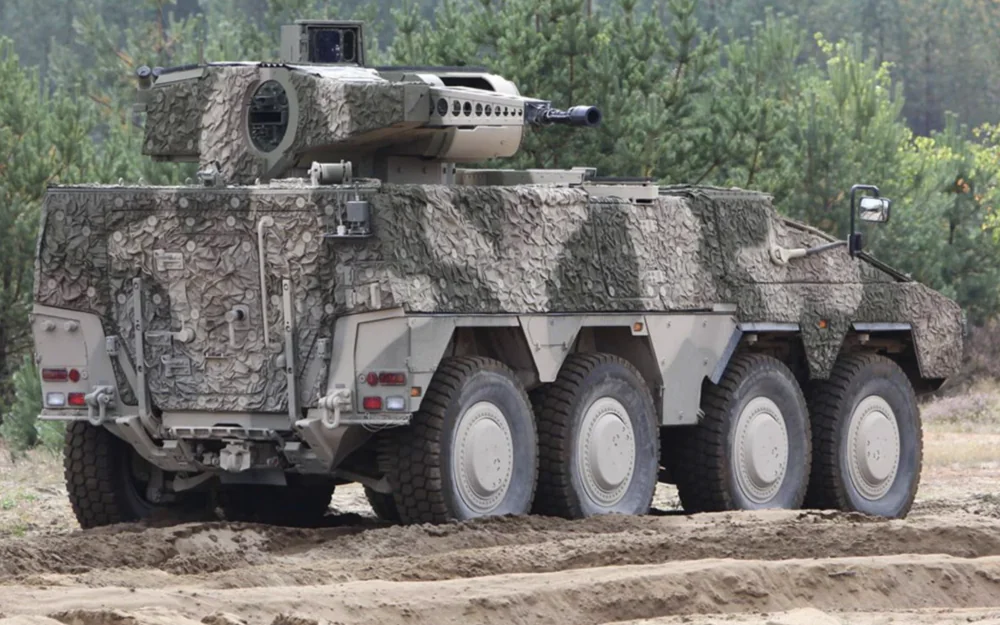
The Boxer RCT 30 IFV is equipped with a modern electro-optical system for detecting and engaging targets at long ranges. Its stabilized platform enables accurate fire while on the move.
The vehicle’s primary weapon, a 30 mm Mk30-2/ABM automatic cannon, can fire both armor-piercing and high-explosive shells, including programmable munitions designed to target moving threats behind cover. Additional armaments include a coaxial 7.62 mm machine gun, with the option to mount launchers for anti-tank missiles, such as the Spike system.

The Boxer RCT 30 is a modern solution designed for combat zone operations, combining high mobility, robust protection, and powerful weaponry. Its modular design allows the vehicle to be adapted for various missions, ranging from troop transport to deploying a combat module. This versatility means the German infantry fighting vehicle can be configured for multiple roles, including infantry support, reconnaissance, medical evacuation, or transporting troops.
The Boxer RCT 30 features multilayered armor capable of withstanding hits from anti-tank grenade launchers, mines, and artillery shrapnel. Crew protection is enhanced by anti-mine safety systems and optional active protection systems, such as Trophy or Iron Fist, designed to intercept incoming rockets and projectiles.
Its powerful engine and advanced suspension provide excellent mobility across various terrains, allowing the vehicle to reach a top speed of up to 100 km/h.
The Boxer RCT 30 is designed with future technologies in mind, enabling the integration of cutting-edge communication, reconnaissance, and active protection systems. Its modular architecture allows for straightforward equipment upgrades, ensuring the vehicle remains relevant and effective for decades to come.
Read also: Capabilities of the AGM-158 JASSM Air-Launched Cruise Missile
History of the creation of the Boxer RCT 30 infantry fighting vehicle
The Boxer RCT 30 is a variant of the Boxer armored vehicle, developed as part of an international program initiated in the 1990s. The primary goal of the project was to create a platform with a high level of protection, mobility, and modularity to meet the diverse demands of modern warfare.
The program was initially spearheaded by Germany, the Netherlands, and the United Kingdom, with the aim of designing a universal combat platform. A key aspect of the concept was its modular design, allowing a single base vehicle to be adapted for various operational roles. In 2003, the United Kingdom withdrew from the project, but Germany and the Netherlands continued its development.
The development of Boxer armored vehicle variants was handled by the ARTEC consortium, a joint venture between Krauss-Maffei Wegmann and Rheinmetall. The first prototypes were completed in the mid-2000s, with serial production beginning in 2011. The vehicle features advanced protection levels and a modular design, enabling rapid replacement or adaptation of combat modules to suit various operational requirements.
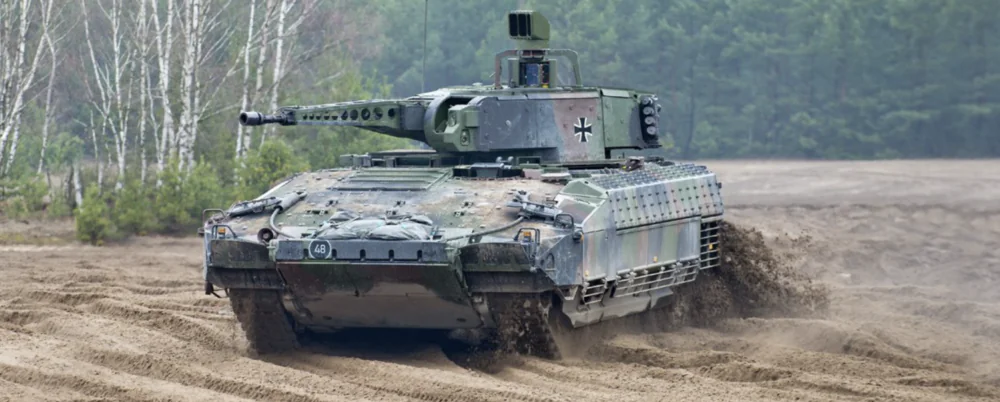
The concept of the RCT 30 emerged in the 2010s, driven by advancements in automated combat systems and the growing demand for remotely operated modules. In collaboration with Rheinmetall, the Boxer RCT 30 combat module was developed, featuring a 30 mm automatic cannon. The primary objective of this module is to enhance firepower while ensuring crew safety through remote operation.
In 2015, Rheinmetall successfully integrated the RCT 30 module onto the Boxer platform. During this period, the vehicle received upgrades to its fire control systems, improved firing accuracy, and enhanced compatibility with anti-tank missiles. Soon after, prototypes underwent testing both within Germany and internationally.
The serial production of the Boxer RCT 30 infantry fighting vehicle began in early 2020. Several units were immediately adopted by multiple countries, including the German Bundeswehr. The vehicle is deployed as part of mechanized units, designed to perform a range of tasks in various combat scenarios.
The Boxer RCT 30 infantry fighting vehicle has proven to be a valuable asset on training grounds and in combat environments, largely due to its key innovations. The modular Boxer platform is not limited to the RCT 30 module; it can accommodate other configurations depending on mission requirements. The remotely operated weapon system allows the crew to remain protected within the armored vehicle while controlling the weaponry through advanced digital systems.
The Boxer RCT 30 is the result of years of collaboration between engineers, military experts, and industry professionals. It stands as one of the most advanced combat vehicles in its class, designed to meet the demands of modern battlefields.
Read also: Weapons of Ukrainian Victory: V-BAT Vertical Takeoff UAV
Design and protection of the Boxer RCT 30
The Boxer RCT 30 combines innovative design with a high level of protection, making it an effective and resilient combat platform on the modern battlefield.
At its core, the Boxer infantry fighting vehicle utilizes the versatile Boxer platform, designed as a modular system. The vehicle consists of a basic chassis (either two-axle or four-axle) and an interchangeable functional module—in this case, the RCT 30 combat module.
The modular design allows for easy conversion of the vehicle into different configurations (such as medical or command). This provides straightforward maintenance and the ability to upgrade the vehicle when needed.
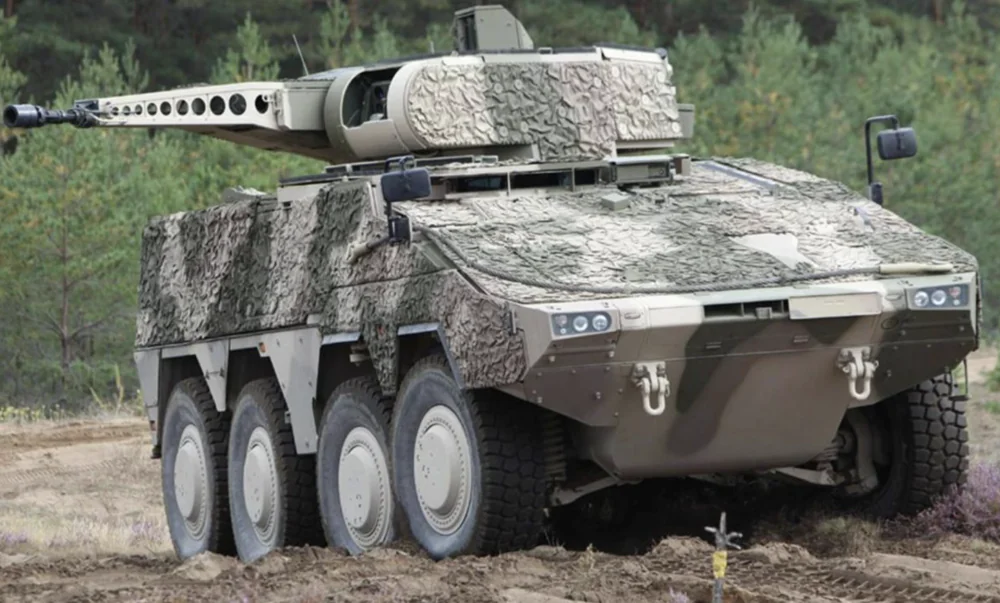
The German Boxer RCT 30 infantry fighting vehicle features a low profile, which reduces its visibility on the battlefield. The spacious interior allows for comfortable accommodation of a 3-person crew and up to 8 soldiers.
The remotely operated module mounted on the roof provides full 360-degree visibility and is well-protected from enemy fire. The modern design of the module also allows for the integration of additional systems, such as sensors, drones, or active protection.
The use of modern materials and the vehicle’s shape reduce its radar and infrared signature. This enhances the protection of the hull and crew.
The main armor of the Boxer RCT 30 IFV consists of multi-layered composite armor, providing protection against large-caliber bullets (up to 14.5 mm), artillery shell fragments, and explosions from handheld anti-tank grenades.
The Boxer RCT 30 is designed to ensure crew survival in the event of mine explosions or improvised explosive devices (IEDs). The special V-shaped hull helps dissipate the energy from blasts. Additionally, the suspension and crew seats absorb shockwaves.
This German IFV can be equipped with active protection systems such as Trophy or Iron Fist, which detect and neutralize incoming missiles before they can make contact with the vehicle. The inclusion of smoke grenade launchers allows for the creation of an aerosol curtain, providing protection against laser and thermal imaging targeting systems.
The integrated sensors for laser detection and missile launches allow for immediate responses to threats. The crew is alerted in real time to incoming dangers, enabling quick action.
The Boxer RCT 30 can be adapted to new challenges, including the integration of additional armor panels or the latest active protection systems. Its balanced design ensures stability, even after a blast under the wheels or hull.
Thanks to its high maintainability and survivability, damaged modules can be quickly replaced on the battlefield, minimizing downtime. Modern technologies give it an edge over most similar vehicles. The Boxer RCT 30 is an example of the ideal combination of innovative design, advanced technologies, and a high level of protection, making it one of the top combat vehicles of today.
Read also: Weapons of Ukrainian Victory: LAV 6.0 ACSV Armored Personnel Carrier
Engine and driving characteristics
The Boxer RCT 30 stands out with its powerful engine and advanced mobility features, offering high reliability and mobility even in challenging environments.
The Boxer modular platform is equipped with the MTU 8V199 TE21 8-cylinder diesel engine, commonly used in many modern military vehicles. The engine delivers 815 hp (530 kW), ensuring an excellent power-to-weight ratio. Positioned at the front of the hull, the engine improves crew protection in the event of mine explosions under the rear of the vehicle. Both the engine and transmission are controlled by a modern electronic system that automatically optimizes engine performance based on terrain conditions.
The turbocharging system enhances performance at high altitudes and in extreme temperatures. It’s worth noting that this powertrain is quite fuel-efficient, offering low fuel consumption for extended missions. The robust design and use of high-quality materials contribute to the vehicle’s high reliability and longevity.
The Boxer RCT 30 is equipped with an automatic transmission, the Renk HSWL 256, which ensures smooth gear shifts. The full 8×8 all-wheel-drive system provides excellent mobility and stability, even in rugged terrain. The hydraulic steering with rear-wheel steering improves the vehicle’s maneuverability. The independent hydro-pneumatic suspension for each wheel ensures a smooth ride, even on uneven surfaces. The vehicle maintains stability on slopes up to 30° and can handle side inclines of up to 20°.
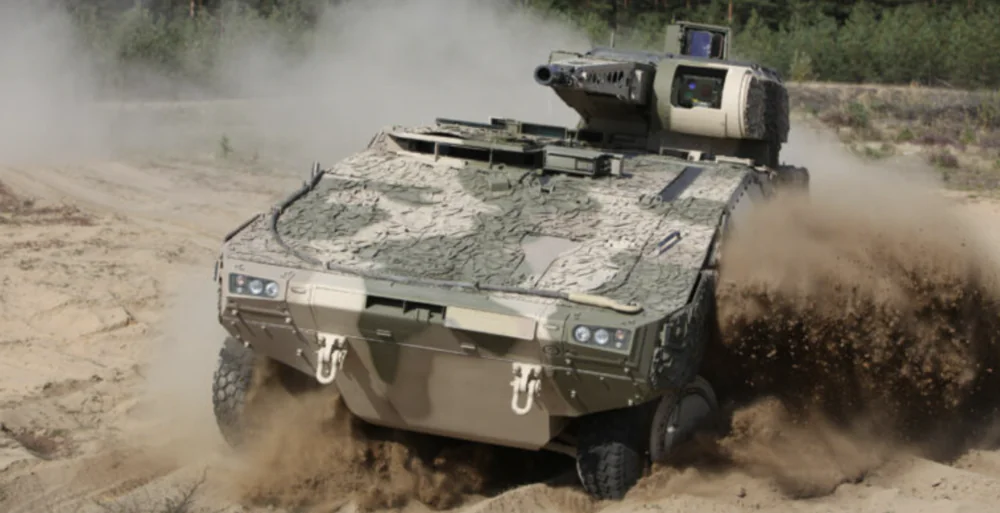
The Boxer RCT 30 is capable of reaching a top speed of 100 km/h on highways, with an average speed of 50-70 km/h in rough terrain. It also boasts a significant operational range, capable of traveling up to 1050 km on a single fuel tank.
Interestingly, the infantry fighting vehicle can cross a ford up to 1.5 meters deep without preparation and can also navigate ditches up to 2 meters wide. Additionally, it can climb vertical obstacles up to 0.8 meters high. The Boxer RCT 30 has a turning radius of approximately 15 meters, which is a notable achievement for a vehicle in this class. Thanks to its adjustable suspension and powerful transmission, the vehicle can quickly adapt to changes in position on the battlefield.
The Boxer RCT 30 is designed for operation in the harshest conditions, ranging from extreme cold to high temperatures. It strikes an ideal balance between power, endurance, and maneuverability, making it a crucial component of modern mechanized units. The ease of maintenance for the engine and drivetrain allows for repairs to be carried out in the field.
Read also: Weapons of Ukrainian Victory: Precision-Guided AGM-154 JSOW Glide Bomb
Armament of the Boxer RCT 30 infantry fighting vehicle
The Boxer RCT 30 features a cutting-edge combat module that provides impressive firepower, accuracy, and versatility. The weaponry of this vehicle allows it to effectively perform a wide range of tasks, from infantry support to combating enemy armored vehicles.
This infantry fighting vehicle, based on the Boxer GTK PuBo platform, is equipped with the remotely operated RCT30 turret from the Puma MK30-2/30 mm IFV. It is capable of engaging targets at distances of up to 3,000 meters, both while stationary and on the move.
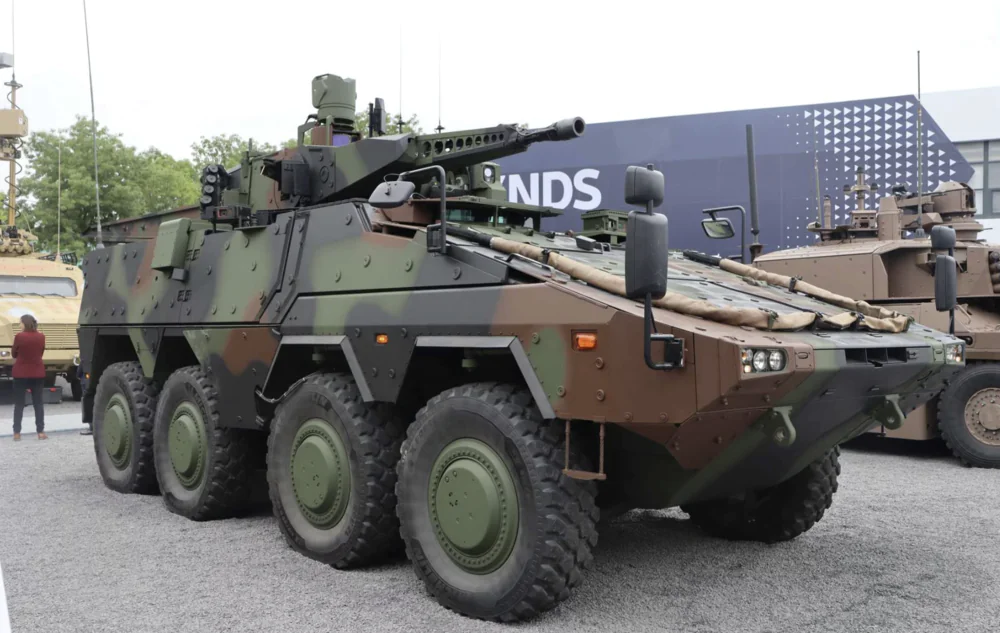
The main armament of the Boxer RCT 30 is the 30 mm Mk30-2/ABM automatic cannon, which boasts a high rate of fire of up to 200 rounds per minute. The stabilizing system ensures shooting accuracy even while on the move. The total ammunition load depends on the mission.
This can include armor-piercing rounds for engaging lightly armored targets, high-explosive fragmentation rounds for targeting personnel, and programmable munitions that explode in the air, allowing for the destruction of targets behind cover or drones.
One of the most interesting components of the Boxer RCT 30’s armament could be the Spike-LR anti-tank guided missiles (ATGMs). The vehicle is equipped with two ready-to-launch missiles, with additional ones stored inside. The effective range of the missile is up to 4000 meters. It features a “fire-and-forget” guidance system, and is capable of penetrating up to 1000 mm of armor, even with dynamic protection. The missile uses a two-stage guidance system, incorporating infrared homing and fiber-optic communication for trajectory correction. This enables the destruction of tanks, infantry fighting vehicles, fortifications, and other heavily armored targets.
Additionally, the Boxer RCT 30 can be equipped with a paired 7.62 mm machine gun (MG5 or FN MAG), with a magazine capacity of up to 1000 rounds, ready for use. These can be employed to target enemy infantry and light vehicles.
Also worth mentioning are the smoke grenade launchers, positioned on both sides of the module. The BMP has a total of 8 grenades in its arsenal, which can be used to create a smoke screen, masking the vehicle from enemy targeting systems.
Read also: Laser Weapons: History, Development, Potential, and Prospects
Fire control system
The modern fire control system (FCS) of the Boxer RCT 30 ensures high accuracy, quick response time, and target engagement effectiveness in any combat conditions. It integrates advanced technologies for detecting, tracking, and destroying the enemy, making the vehicle one of the leaders in its class.
The weaponry is controlled through a unified system that consists of several components. First and foremost, this includes the main sight with both day and thermal imaging channels. It is complemented by a laser rangefinder for precise distance measurement to the target. Completing the system is the automatic target tracking feature.
The crew receives data from the situational awareness system, which is integrated into the overall battle management system. The commander’s panoramic sight offers a 360° field of view, ensuring complete situational awareness. This allows the commander to independently search for targets while the gunner is operating the system.
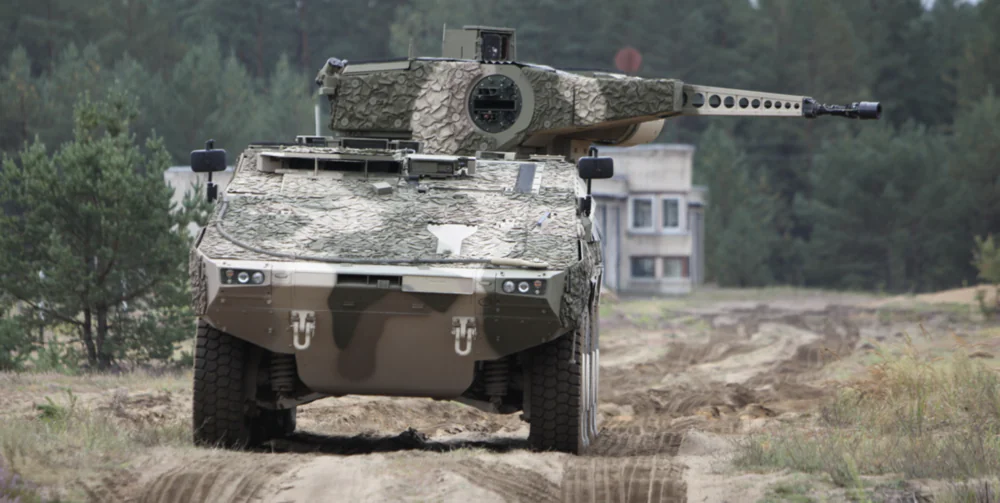
The Boxer RCT 30 can operate with reconnaissance drones to gather real-time intelligence about enemy positions. The data from the drones is transmitted to the fire control system for precise weapon targeting.
Integrated sensors for laser irradiation and missile launches alert the crew to threats. The system automatically aims the weapons at the source of the threat or activates protective measures (such as smoke grenades).
The Boxer RCT 30 is equipped with artificial intelligence elements for target identification, predicting their movement, and suggesting the optimal method of engagement (using the cannon, machine gun, or missiles). The automatic fire control system reduces the crew’s workload and accelerates the decision-making process.
Read also: Weapons of Ukrainian Victory: Viking Bandvagn S10 All-Terrain Vehicle
The crew and troops
The Boxer RCT 30 combines a high level of protection for the crew and infantry, along with convenience for work inside the vehicle and functionality that allows effective execution of combat tasks. The layout and interior space of the vehicle are designed with a focus on ergonomics and safety.
The Boxer RCT 30 requires a standard crew of three people: commander, gunner, and driver-mechanic. The commander is responsible for managing the combat vehicle, coordinating the crew’s actions, and interacting with other units. They use the panoramic sight with a 360° view, which ensures situational awareness, and have access to fire control and communication systems.
The gunner controls the weaponry, which includes the Mk30-2/ABM cannon, a machine gun, and a launcher for the anti-tank guided missiles (ATGMs). They utilize high-precision targeting systems for firing, ensuring the destruction of priority targets.
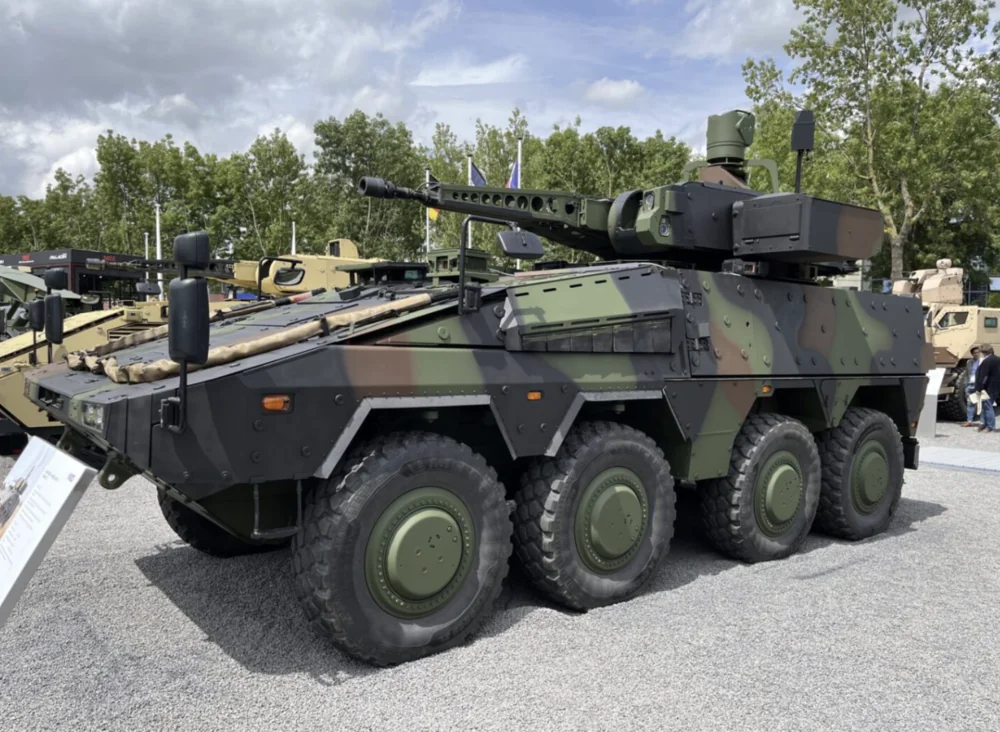
The driver-mechanic is responsible for the vehicle’s movement, maneuverability, and selecting the optimal route. They are positioned in the front of the hull and are equipped with their own observation instruments (day and night vision). The driver receives information from the vehicle’s diagnostic system, which automatically alerts them to the technical condition of the machine.
The Boxer RCT 30 can carry up to 8 fully equipped soldiers as part of the infantry section. Their seats are arranged along the sides of the vehicle in a blast-resistant configuration. The high level of ergonomics ensures comfort even during long missions. Additionally, the troop compartment is reinforced with armor, providing protection against bullets, shrapnel, and mines. The seats are mounted to the ceiling, minimizing the impact of the blast wave from explosions under the vehicle.
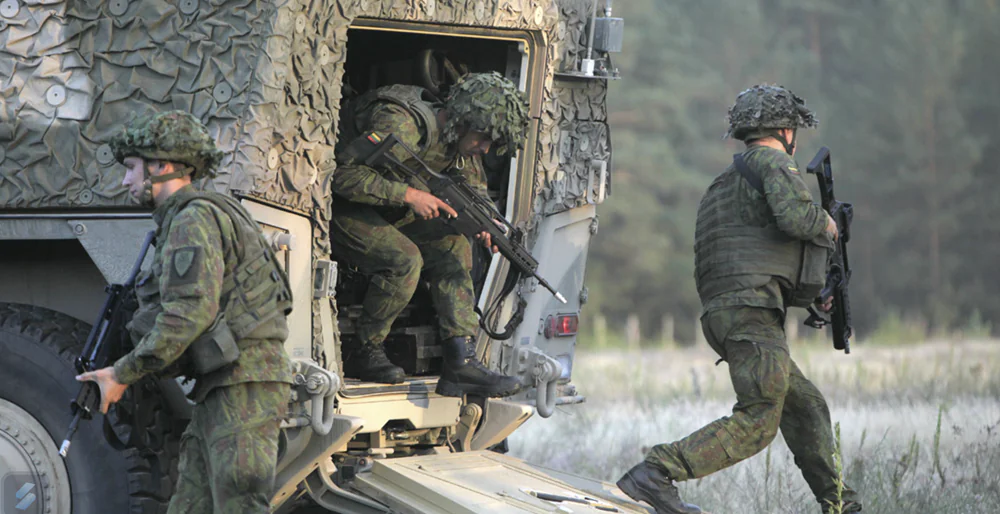
The large rear ramp with hydraulic drive enables quick loading and unloading of the troops. There are also additional hatches for emergency evacuation. For the convenience and comfort of the infantry, the compartment is equipped with climate control, maintaining a comfortable temperature even in harsh environmental conditions.
An important feature is the integration of communication systems, allowing each soldier to connect to the onboard communication network. Additionally, the troop compartment is equipped with observation devices, enabling the troops to monitor the surrounding environment. This facilitates more efficient deployment in combat zones.
The modular AMAP armor provides protection against calibers up to 14.5 mm, artillery shell fragments, and landmine explosions. It can be upgraded based on the threat level, which is crucial in modern combat conditions.
The Boxer RCT 30 demonstrates an ideal balance between combat capabilities and crew and troop comfort, making it an effective tool in modern warfare.
Read also: Weapons of Ukrainian Victory: Mistral Anti-Aircraft Missile System
Tactical and technical characteristics
- Wheel arrangement: 8×8 (Iveco chassis is used)
- Engine: MTU 8V199 TE21 diesel engine
- Armament: 30 mm Mk30-2/ABM automatic cannon, twin 7.62 mm machine guns (MG5 or FN MAG) and Spike-LR anti-tank guided missiles
- Length: 7.9 m
- Width: 2,99 m
- Height: 3,5 m
- Weight: 38.5 tons
- Engine power: 815 hp (530 kW)
- Top speed: over 100 km/h
- Range: over 700 km
- Armored personnel carrier platform: Boxer
- RCT30 turret of unmanned design
- Number of crew: 3 people (driver, gunner and commander)
- Troops: up to 8 people.
Boxer RCT 30 is not just an armored vehicle; it is a true “smart soldier” equipped with cutting-edge technologies to ensure dominance on the modern battlefield.
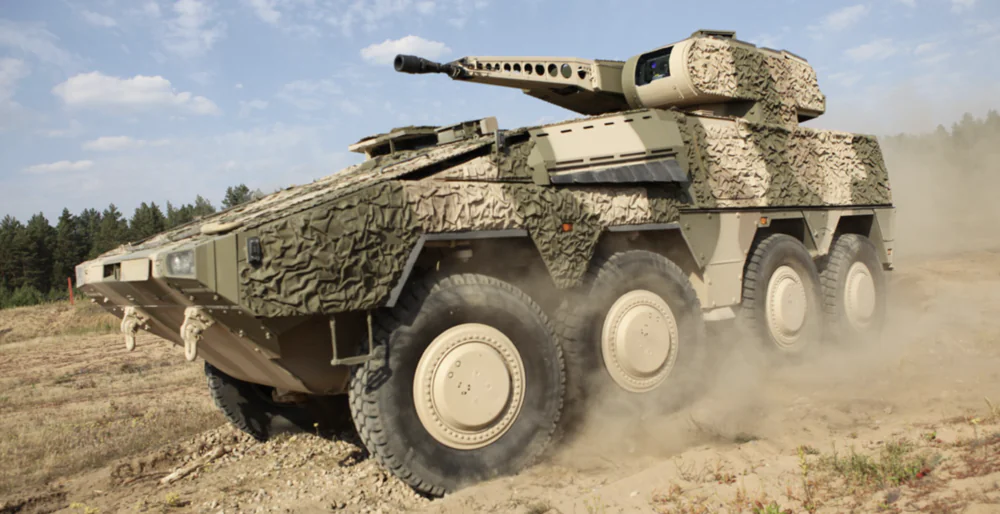
The infantry fighting vehicles are already helping the Ukrainian military destroy the enemy at the front. I am confident that such a reliable and protected infantry fighting vehicle is very necessary for our defenders. That is why we are sincerely grateful to our Western partners for their support and supply of modern weapons.
The invaders will not escape from retribution. Death to the enemies! We believe in our Victory! Glory to the Armed Forces! Glory to Ukraine!
Read also:
- Top 8 Military Technologies of the Future to Pay Attention to Today
- Top 10 Most Important Known Military Satellites

